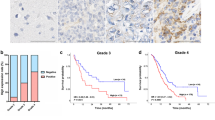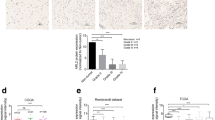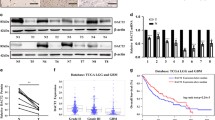Abstract
Objective
To confirm the role played by AKT1 and AKT2 in the β-catenin/ Tcf-4 signaling pathway in promoting malignant transformation of glioma cells.
Methods
LN229 cells were divided into five groups: a control group, acetone (ACE)group, acetylsalicylic acid (ASA; aspirin) group, ASA+AKT1 plasmid group and ASA+AKT2 plasmid group. Western blot and PCR were used to detect the expression of AKT1 and AKT2 after dealing with ASA and transferring AKT1/2 genes into LN229 cells. Cell proliferation was determined by flow cytometry, cell invasion was evaluated by transwell assay and cell apoptosis was detected with annexin V staining. The molecules regulating proliferation and invasion were examined by western blot analysis.
Results
Aspirin down-regulates AKT1 and AKT2 expression by modulating b-catenin/Tcf-4 activity. AKT1 and AKT2 can enhance cell proliferation and invasion by up-regulating the expression of cyclin-D and matrix metalloprotein-9 (MMP-9) in LN229 glioma cells.
Conclusion
AKT1 and AKT2 play an important role in the bcatenin/Tcf-4 signaling pathway promoting malignant transformation; AKT1 is more effective than AKT2. AKT1 and AKT2 may be potential targets for brain glioma therapy and an effective way to prevent metastasis of gliomas.
Similar content being viewed by others
Explore related subjects
Discover the latest articles and news from researchers in related subjects, suggested using machine learning.References
Ohgaki H, Kleihues P. Epidemiology and etiology of gliomas. Acta Neuropathol 2005; 109: 93–108.
Clarke J, Butowski N, Chang S. Recent advances in therapy for glioblastoma. Arch Neurol 2010; 67: 279–283.
Liu R, Page M, Solheim K, et al. Quality of life in adults with brain tumors: current knowledge and future directions. Neuro Oncol 2009; 11: 330–339.
Ying Y, Tao Q. Epigenetic disruption of the WNT/betacatenin signaling pathway in human cancers. Epigenetics 2009; 4: 307–312.
Espada J, Calvo MB, Diaz-Prado S, et al. Wnt signalling and cancer stem cells. Clin Transl Oncol 2009; 11: 411–427.
MacDonald BT, Tamai K, He X. Wnt/beta-catenin signaling: components, mechanismsand diseases. Dev Cell 2009; 17: 9–26.
Zhou X, Ren Y, Moore L, et al. Downregulation of miR-21 inhibits EGFR pathway and suppresses the growth of human glioblastoma cells independent of PTEN status. Lab Invest 2010; 90: 144–155.
Yochum GS, Cleland R, Goodman RH. A genome-wide screen for beta-catenin binding sites identifies a downstream enhancer element that controls c-Myc gene expression. Mol Cell Biol 2008; 28: 7368–7379.
Fang D, Hawke D, Zheng Y, et al. Phosphorylation of beta-catenin by AKT promotes beta-catenin transcriptional activity. J Biol Chem 2007; 282: 11221–11229.
Hu T, Li C. Convergence between Wnt-beta-catenin and EGFR signaling in cancer. Mol Cancer 2010; 9: 236.
Liu X, Wang L, Zhao S, et al. β-Catenin overexpression in malignant glioma and its role in proliferation and apoptosis in glioblastma cells. Med Oncol 2010; 28: 608–614.
Dihlmann S, Kloor M, Fallsehr C, et al. Regulation of AKT1 expression by beta-catenin/Tcf/Lef signaling in colorectal cancer cells. Carcinogenesis 2005; 26: 1503–1512.
Wang G, Kang C, Pu P. Increased expression of Akt2 and activity of PI3K and cell proliferation with the ascending of tumor grade of human gliomas. Clin Neurol Neurosurg 2010; 112: 324–327.
Zhang B, Gu F, She C, et al. Reduction of Akt2 inhibits migration and invasion of glioma cells. Int J Cancer 2009 125: 585–595.
Cross DA, Alessi DR, Cohen P, et al. Inhibition of glycogen synthase kinase-3 by insulin mediated by protein kinase B. Nature 1995; 378: 785–789.
Korkaya H, Paulson A, Charafe-Jauffret E, et al. Regulation of mammary stem/progenitor cells by PTEN/ Akt/beta-catenin signaling. PLoS Biol 2009; 7: e1000121.
Mure H, Matsuzaki K, Kitazato KT, et al. Akt2 and Akt3 play a pivotal role in malignant gliomas. Neuro Oncol 2010; 12: 221–232.
Pu P, Kang C, Li J, et al. Antisense and dominant-negative AKT2 cDNA inhibits glioma cell invasion. Tumour Biol 2004; 25: 172–178.
Fortin SP, Ennis MJ, Savitch BA, et al. Tumor necrosis factor-like weak inducer of apoptosis stimulation of glioma cell survival is dependent on Akt2 function. Mol Cancer Res 2009 7: 1871–1881.
Zhang B, Gu F, She C, et al. Reduction of Akt2 inhibits migration and invasion of glioma cells. Int J Cancer 2009; 125: 585–595.
Author information
Authors and Affiliations
Corresponding author
About this article
Cite this article
Zou, J., Wang, K., Han, L. et al. AKT1 and AKT2 promote malignant transformation in human brain glioma LN229 cells. Clin. Oncol. Cancer Res. 8, 144–148 (2011). https://doi.org/10.1007/s11805-011-0573-9
Received:
Accepted:
Published:
Issue Date:
DOI: https://doi.org/10.1007/s11805-011-0573-9




